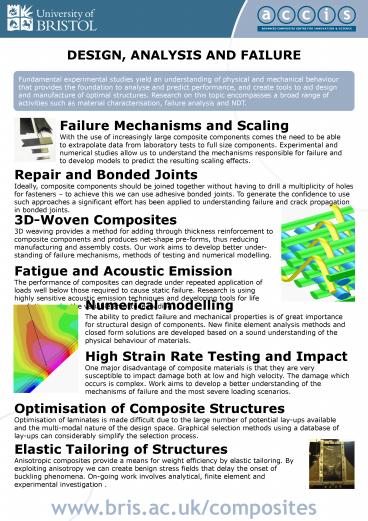Numerical modelling - PowerPoint PPT Presentation
1 / 2
Title:
Numerical modelling
Description:
Optimisation of Composite Structures. Optimisation of laminates is made difficult due to the large ... numerical modelling and optimization to create high ... – PowerPoint PPT presentation
Number of Views:112
Avg rating:3.0/5.0
Title: Numerical modelling
1
DESIGN, ANALYSIS AND FAILURE
Fundamental experimental studies yield an
understanding of physical and mechanical
behaviour that provides the foundation to analyse
and predict performance, and create tools to aid
design and manufacture of optimal structures.
Research on this topic encompasses a broad range
of activities such as material characterisation,
failure analysis and NDT.
Failure Mechanisms and Scaling With the use of
increasingly large composite components comes the
need to be able to extrapolate data from
laboratory tests to full size components.
Experimental and numerical studies allow us to
understand the mechanisms responsible for failure
and to develop models to predict the resulting
scaling effects.
Repair and Bonded Joints Ideally, composite
components should be joined together without
having to drill a multiplicity of holes for
fasteners to achieve this we can use adhesive
bonded joints. To generate the confidence to use
such approaches a significant effort has been
applied to understanding failure and crack
propagation in bonded joints.
3D-Woven Composites 3D weaving provides a method
for adding through thickness reinforcement to
composite components and produces net-shape
pre-forms, thus reducing manufacturing and
assembly costs. Our work aims to develop better
under-standing of failure mechanisms, methods of
testing and numerical modelling. Fatigue and
Acoustic Emission The performance of composites
can degrade under repeated application of loads
well below those required to cause static
failure. Research is using highly sensitive
acoustic emission techniques and developing tools
for life prediction under the variable amplitude
loading .
Numerical modelling The ability to predict
failure and mechanical properties is of great
importance for structural design of components.
New finite element analysis methods and closed
form solutions are developed based on a sound
understanding of the physical behaviour of
materials. High Strain Rate Testing and
Impact One major disadvantage of composite
materials is that they are very susceptible to
impact damage both at low and high velocity. The
damage which occurs is complex. Work aims to
develop a better understanding of the mechanisms
of failure and the most severe loading scenarios.
Optimisation of Composite Structures Optimisation
of laminates is made difficult due to the large
number of potential lay-ups available and the
multi-modal nature of the design space. Graphical
selection methods using a database of lay-ups can
considerably simplify the selection process.
Elastic Tailoring of Structures Anisotropic
composites provide a means for weight efficiency
by elastic tailoring. By exploiting anisotropy we
can create benign stress fields that delay the
onset of buckling phenomena. On-going work
involves analytical, finite element and
experimental investigation .
2
INTELLIGENT STRUCTURES
Composites enable integration of the traditional
disciplines of materials science, mechanical
engineering, computer science, electrical
engineering, numerical modelling and optimization
to create high performance intelligent
structures. The outstanding mechanical properties
of composites enable them to offer exciting
possibilities to create multifunctional adaptive
structures.
Structural Health Monitoring Structural Health
Monitoring can potentially be performed very
efficiently using guided acoustic waves to detect
localized damage in large structures. The sensing
mechanism can be either active or passive and
major research projects in both areas are under
way.
Wireless Intelligent Sensing Devices The
objective is to realise a sensor network with
remote nodes that are autonomous, self-powered,
have on-board intelligence and provide wireless
data transfer. The focus is on sensors fitted to
the rotor hub of a helicopter an area that is
difficult to instrument using conventional
technologies.
Morphing Aircraft Morphing aircraft are flight
vehicles that are able to change their shape to
effect a change in the mission of the aircraft,
to improve performance or to perform flight
control without conventional control surfaces.
The concept of the morphing aircraft is to fully
integrate the shape control into the wing
structure.
Self-deployable honeycombs We are developing
honeycomb structures made from shape memory alloy
material to provide revolutionary cellular solids
with enhanced damping capacity, active strain
storage and deployment capabilities.
Demonstrators are developed using hexagonal and
auxetic configurations. Polymorphic Composite
Structures Polymorphic composite structures are
defined as those structures that differ in shape
and geometry from the tooling from which they are
made, and which may exhibit more than one stable
shape in their final form. Polymorphic structures
have enormous potential in the field of adaptive
structures.
Self actuating composites One aspect of this work
is the combination of polymorphic composite
structures with low profile actuation solutions
such as piezoelectric patches. This generates a
bi-stable plate that can be snapped between two
stable states in a controllable and predictable
fashion, thus creating a morphing structure.
Another aspect is the use of compliant structures
(structures with low stiffness) as these can
produce large displacements resulting in shape
change.
Damage prognosis Developments in sensors and
damage detection techniques mean that a lot of
information can now be obtained on the state of
the structure. For example full field strain
measurements are being used to predict the extent
of damage by the effect it has on the surface
displacements or strain distributions. This
approach is being applied to damage prognosis by
combining techniques for detecting damage with
models to predict its effect on the integrity of
the structure and its remaining life.































